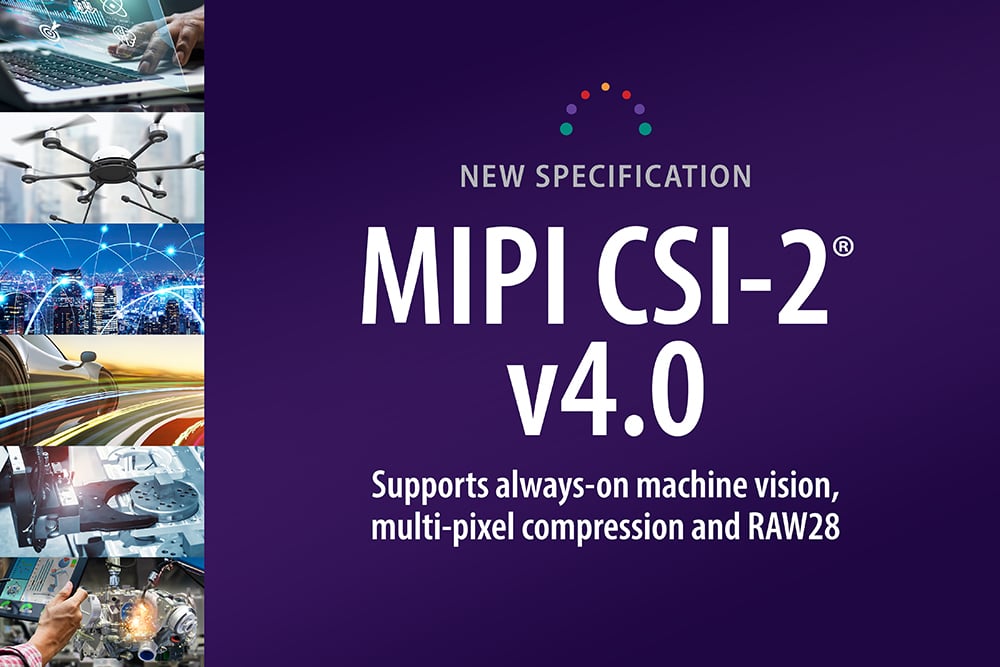2 min read
Major CSI-2 Update Supports Always-On, Low-Power, Machine-Vision Applications
![]() Sharmion Kerley, MIPI Director of Marketing and Membership
:
10 February 2022
Sharmion Kerley, MIPI Director of Marketing and Membership
:
10 February 2022

- News & Events
- News
- Blog
A major update to the world’s most widely implemented embedded camera and imaging interface delivers a scalable foundation upon which next-generation artificial intelligence and machine‑vision systems can enhance human-device interaction. Version 4.0 of the MIPI Camera Serial Interface 2 (MIPI CSI-2®) introduces key new features that continue to build on CSI-2's capabilities to bring sight to artificial intelligence (AI) and support advanced machine-vision applications across multiple application spaces, such as mobile, augmented and virtual reality, drones, the Internet of Things (IoT), medical devices, industrial systems, automobiles, and client devices including tablets, notebooks and all-in-ones.
Originally introduced in 2005, MIPI CSI-2 is a lane-scalable, high-speed protocol for the transmission of still and video images from image sensors to application processors. The specification supports a broad range of use cases that require high performance, low power and low electromagnetic interference (EMI).
An 8 February MIPI Alliance press release details three key new features delivered in MIPI CSI-2 v4.0:
- Always-On Sentinel Conduit (AOSC) enables always-on machine-vision systems in which combinations of ultra-low-power image sensors and video signal processors (VSPs) can continuously monitor their surrounding environments and then wake their higher-power host central processing units (CPUs) only when significant events happen. AOSC enables image frames to be economically streamed from an image sensor to a VSP over a low-power MIPI I3C® bus in a highly efficient manner, with scaling options to add extra I3C lanes and bandwidth as defined by the I3C specification.
- Multi-Pixel Compression (MPC) provides optimized pixel compression for the latest generation of very-high-resolution Tetra-Cell and Nona-Cell image sensors with multi-pixel color filter arrays (CFAs).
- RAW28 color depth pixel encoding delivers unprecedented image quality and superior signal-to-noise (SNR) ratio for the next generation of high-dynamic-range automotive image sensors for safety-critical applications. Previous versions of the specification offer support for RAW 16, 20 and 24, and all versions of CSI-2 are also backward compatible with previous versions.
Those new features in CSI-2 v4.0 are normative-optional. “This provides system implementers with the flexibility to strategically and efficiently deploy only those capabilities that they need to enable their specific, emerging imaging and vision applications,” said Tom Kopet, who recently became chair of the MIPI Camera Working Group. For example, the new version of the specification can be leveraged to lower cost and complexity barriers for next-generation inferencing solutions and efficiently achieve the enhanced image quality and SNR demanded by premium imaging applications.
Version 4.0 of the specification is notable, too, in that it is the first to support transmission of CSI‑2 image frames over the low-cost, low-pin-count MIPI I3C/I3C Basic two-wire interface (for implementation of the AOSC feature). CSI-2 is typically implemented for shorter-reach applications on either a MIPI C-PHYSM or MIPI D-PHYSM physical-layer interface, and it also can be implemented over the MIPI A-PHYSM long-reach SerDes interface (up to 15m) for use in such applications as automotive advanced driver assistance systems (ADAS) and in-vehicle infotainment, as well as industrial IoT.
“With its new features, v4.0 vastly expands the range of application, from simplified low-power environmental monitoring, to compression and superior image quality for high-performance, safety-critical applications,” MIPI Alliance Chairman Joel Huloux said in the press release.
For more information about the new version, please see the MIPI CSI-2 v4.0 Panel Discussion with the MIPI Camera Working Group presented at the September 2021 MIPI Developers Conference (MIPI DevCon), in which members of the group presented a detailed overview of each of the highlighted new CSI-2 v4.0 features.







